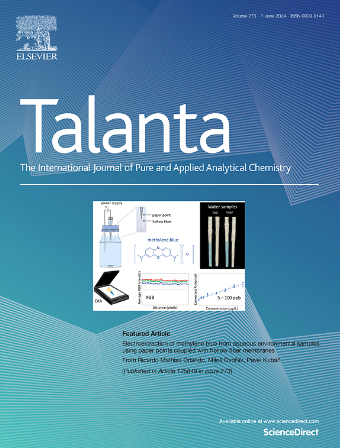AuNCs@ZIF-8 with enhanced AIE effect to develop a lateral flow immunosensor for POC dual-modal detection of acetochlor
IF 5.6
1区 化学
Q1 CHEMISTRY, ANALYTICAL
引用次数: 0
Abstract
Regarding the high incidence of residue and serious toxicity of acetochlor (ATC) pesticide, it is urgent to explore simple and low-cost methods for their sensitive detection in food. In this study, with zeolite-like imidazole frameworks (ZIFs) as the carriers for embedding glutathione-modified luminescent gold nanoclusters (GSH-AuNCs) exhibiting aggregation-induced emission (AIE) effect, a GSH-AuNCs@ZIF-8 probe driven strip-based lateral flow immunosensor (LFIS) was developed for visual qualitative and fluorescent quantitative dual-modal detection of ATC. The encapsulation of GSH-AuNCs into ZIF-8 with restriction effect not only significantly improved the stability and anti-interference ability of AuNCs, but also remarkably enhanced the fluorescence efficiency for signal amplification due to the enhanced AIE effect of GSH-AuNCs, endowing the LFIS platform with unique performance. Under optimal conditions, the LFIS platform could realize the point-of-care visualization and quantitation of ATC within 20 min with a detection limit of 8.3 pg/mL and a broad linear range of 0.01–10.0 ng/mL. High recoveries of 96.44%–106.8 % in the spiked ginger samples confirmed the outstanding accuracy and dependability of the new platform for ATC analysis of real samples. Compared with other immunoassays, the AuNCs@ZIF-8-based dual-modal LFIS exhibited the advantages of simple preparation, simple operation, short analytical time, and low cost, which could be expanded to monitor more pesticides and more trace contaminants in diverse food and agricultural products, and medicinal material matrices.

求助全文
约1分钟内获得全文
求助全文
来源期刊

Talanta
化学-分析化学
CiteScore
12.30
自引率
4.90%
发文量
861
审稿时长
29 days
期刊介绍:
Talanta provides a forum for the publication of original research papers, short communications, and critical reviews in all branches of pure and applied analytical chemistry. Papers are evaluated based on established guidelines, including the fundamental nature of the study, scientific novelty, substantial improvement or advantage over existing technology or methods, and demonstrated analytical applicability. Original research papers on fundamental studies, and on novel sensor and instrumentation developments, are encouraged. Novel or improved applications in areas such as clinical and biological chemistry, environmental analysis, geochemistry, materials science and engineering, and analytical platforms for omics development are welcome.
Analytical performance of methods should be determined, including interference and matrix effects, and methods should be validated by comparison with a standard method, or analysis of a certified reference material. Simple spiking recoveries may not be sufficient. The developed method should especially comprise information on selectivity, sensitivity, detection limits, accuracy, and reliability. However, applying official validation or robustness studies to a routine method or technique does not necessarily constitute novelty. Proper statistical treatment of the data should be provided. Relevant literature should be cited, including related publications by the authors, and authors should discuss how their proposed methodology compares with previously reported methods.
 求助内容:
求助内容: 应助结果提醒方式:
应助结果提醒方式:


